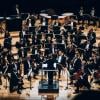
As the San Francisco Symphony’s blazing performance of Handel’s Music for the Royal Fireworks drew to a close on Thursday night, the audience did not hear the composer’s intended ending. The orchestral suite, composed in 1749 to celebrate the signing of a treaty between England and France, originally concluded with two minuets, the first in D minor, the second in a triumphant D major. However, conductor Jane Glover had rearranged the suite, moving the fourth movement, “La Réjouissance” (Rejoicing), to the end, making for a celebratory conclusion more typical of the symphonic repertoire.
Rearranging Handel’s music is nothing controversial — the composer famously reused music between compositions, and the orchestral version of the Fireworks is a rescoring of a piece that was originally written only for winds. But Glover’s intervention revealed the challenges of bringing Baroque music to the symphonic stage.

The evening’s program was built around pieces by Bach and Handel. Such 18th-century works could once only be heard in transmogrified renditions, like Leopold Stokowski’s arrangements of Bach, which imposed a Romantic performance tradition on their source material. But listeners now have access to a rich trove of historically informed performances, both on recordings and in performance by groups like San Francisco’s Philharmonia Baroque Orchestra. So why should an organization like the SF Symphony continue to perform such music on modern instruments, setting aside attempts at historical authenticity and adapting it for the unnatural environment of an orchestral program?
Glover and the SF Symphony (in pared-down, Baroque-friendly numbers) made a compelling case for the continued presence of Baroque music in orchestral halls; it was a lovely musical evening. Bach’s Magnificat, a 25-minute work for chorus, orchestra, and soloists, provided a festive curtain-raiser. The SF Symphony Chorus, although a bit too large and lumbering for the composer’s sinuous counterpoint, sang with energetic power and verve. In the “Omnes generationes” and “Gloria Patri” movements, Glover summoned a powerful, robust sound from her forces, illuminating the music’s celebratory character.
The arias were less successfully brought off. Unfortunately, the vocal soloists were placed behind the orchestra, making them difficult to hear. In “Et misericordia,” an alto-tenor duet, accompanying figures in the violins frequently covered the voices, although singers Leandra Ramm and Michael Jankosky created a pleasing interplay between their melodic lines. While Glover’s vigorous conducting style benefited the choral movements, the quieter and more intimate arias lacked space to breathe. The conductor’s tempos tended to be brisk — this is not an inherent problem, but it prevented the singers from achieving the necessary lyrical phrasing. In the melancholic “Quia Respexit,” for instance, soprano Cheryl Cain seemed to be hurried along by Glover’s inflexible beat. Jankosky was a standout in his aria, singing with gravitas and a rich texture in his upper range.
The Fireworks music was also plagued by a certain monotony. While the overall character of the piece is undoubtedly one of extroverted jubilation, Glover plunged through the score with speedy, rigid tempos that obscured moments of surprise and created a predictable character. Nevertheless, the orchestra shone here; the trumpets pronounced bold, bright fanfares, the winds intoned harmonious chorales, and the strings trilled with fluttering precision.

More excellent musicianship was on display in Bach’s Concerto for Oboe and Violin in D Minor. The version of the piece we heard is a reconstruction by Max Schneider based on a concerto for two harpsichords in C minor; it is assumed that this harpsichord version was an arrangement of an earlier source, which may have included oboe and violin. Principal oboe Eugene Izotov and concertmaster Alexander Barantschik were the soloists, and they played with pleasantly languid phrasing throughout. Barantschik’s tone was robust and meaty, and Izotov made the oboe sound like caramel; their interactions were natural and effortless.
As a palate cleanser, before the Handel that concluded the program, we heard Spectacle of Light, a 2020 composition by Stacy Garrop inspired by the Royal Fireworks. Garrop’s piece had charming energy, and she cleverly incorporated material from Handel’s music, but it was too anodyne to make a deep impression.
Despite the challenges in bringing Baroque music to the orchestral stage, Glover and the SF Symphony delivered a worthwhile performance of some gems from the repertoire. One minor quibble: It would have been useful if the printed program had reflected Glover’s modification of the order of the movements in the Handel; the program notes specifically addressed the significance of ending with a minuet, a comment that didn’t apply in light of the revised performance choice and made for a confusing listening experience.




